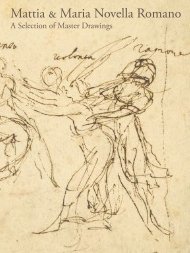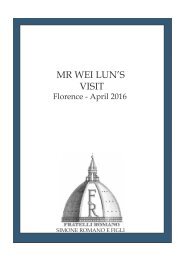A Selection of master drawings 2014
- No tags were found...
Create successful ePaper yourself
Turn your PDF publications into a flip-book with our unique Google optimized e-Paper software.
3 Fine Old Master Drawings, London, Christie’s, 7 April 1970, n. 87<br />
4 See D. Biagi Maino, 1990, p. 28, note 15 and fig. III<br />
5 See D. Biagi Maino, op.cit. p. 28<br />
6 See M. C. Fabbri, Disegni italiani del Sei - Settecento, exh. cat., curated by E. Frascione , Fiesole, 1991, pp. 52-53.<br />
Literature:<br />
D. Biagi Maino, Gli inizi dei Gandolfi e la cultura artistica bolognese alla metà del Settecento, in «Annali della Fondazione di Studi Roberto<br />
Longhi», 1989, II, pp. 125-143; D. Biagi Maino, Ubaldo Gandolfi, Torino, 1990; D. Biagi Maino, Gandolfi, Ubaldo, in La pittura in Italia.<br />
Il Settecento, Milan, 1990, II, pp. 730-731; M. C. Fabbri, Disegni italiani del Sei - Settecento, exh. cat. by E. Frascione, Fiesole, 1991, n. 23,<br />
pp. 52-53; P. Bagni, I Gandolfi, Bologna, 1992, pp. 628-629.<br />
11. Pietro Antonio Novelli<br />
1 «1795. [Francesco] executes <strong>drawings</strong> expressing narratives and even more <strong>of</strong>ten Venetian and foreign sketches having had the opportunity<br />
to see Trento and Bolzano, splashed in watercolour with ink from China and subsequently coloured; for which he has a great market, as<br />
they are considered ingenious among the learned.» (see. Memorie, in Sehnsucht nach Klassik… 2004, p. 181).<br />
2 See A. Dorigato, in Disegni antichi…1996, pp. 102-111, nn. 1283-1298.<br />
3 See A. Sponchiado, 2006, p. 182.<br />
Literature:<br />
Fantasie pastorali. Canti IV di Pietro Antonio Novelli fra gli Arcadi di Roma, Aristeno Parrasideo, ms. [1799 circa], Venice, Biblioteca del<br />
Seminario Patriarcale, ms. 761.1; Memorie della vita di Pietro Antonio Novelli scritte da lui medesimo, ms. [1787-1800], Venice, Biblioteca<br />
del Seminario Patriarcale, ms. 788.25 (transcribed in Sehnsucht nach Klassik, 2004, pp. 170-184); A. Dorigato, Pietro Antonio Novelli, in<br />
Disegni antichi del Museo Correr, exh. cat. by T. Pignatti, vol. V, Venice 1996, pp. 62-105; G. Wiedmann, Pier Antonio e Francesco Novelli<br />
tra Venezia e Roma, in Il Tempio del Gusto: la pittura del Settecento romano e la sua diffusione a Venezia e a Napoli, E. Borsellino and V. Casale<br />
eds., Florence 2001, pp. 263-276; Sehnsucht nach Klassik. Venezianische Kunst um 1800 aus dem Museo Correr, exh. cat. by M. Brunner and<br />
A. Dorigato, Überlingen 2004; A. Sponchiado, Disegni di Pietro Antonio Novelli per l’edizione Zatta delle “Opere” di Carlo Goldoni, in “Arte<br />
Veneta”, 63, 2006 (2007), pp. 169-182.<br />
12. Crist<strong>of</strong>oro Unterperger<br />
1 His uncles, Michelangelo Unterperger and Francesco Sebaldo, were in fact both painters: the first was the Head <strong>of</strong> the Figurative Art<br />
Academy in Wien and one <strong>of</strong> Mary Therese <strong>of</strong> Austria’s favourite artists; the second was the most relevant exponent <strong>of</strong> the so-called<br />
“Pictorial School <strong>of</strong> Fiemme Valley”. The family played a decisive role in the artistic life <strong>of</strong> Crist<strong>of</strong>oro, both for the improvement <strong>of</strong> his<br />
talent, but also for the numerous political and diplomatic relationships with local religious patrons, particularly thanks to his mother<br />
Maria Magdalena Riccabona.<br />
2 Thereafter he never left Rome, except for short periods. The first years were not easy for Unterperger; he could sustain himself thanks to the<br />
commissions coming from his homeland, such as the Portrait <strong>of</strong> Pope Clement XIII for the Convent <strong>of</strong> the Franciscan Fathers <strong>of</strong> Cavalese,<br />
(1759 - 1761) the altarpiece for the Dome in Bressanone representing the Transfiguration <strong>of</strong> Christ on Mount Tabor, dated 1767, and indeed<br />
several other paintings commissioned for Novacella Abbey (1769-1771).<br />
3 He obtained this reward thanks to the intercession <strong>of</strong> Mengs and by virtue <strong>of</strong> his diploma at the Academy in Wien.<br />
4 In particular, see Maria Antonietta De Angelis: «The presence <strong>of</strong> the two big tritons fighting with the griffins in the window vault<br />
can be mainly interpreted as a choice <strong>of</strong> Unterperger to refer to the triton plaster figures on the vault. The triton and the griffin were<br />
typical elements <strong>of</strong> the grotesque, largely employed in Renaissance. Moreover the ‘marine’ connotation and hence, aquatic, <strong>of</strong> the triton,<br />
mythological creature half man and half fish, recalls the symbolic theme <strong>of</strong> the Vestibule. The bickering nature <strong>of</strong> the triton (in mythology<br />
he is famous for fighting with Hercules) was employed in grotesque decorations to be opposed to various other figures, such as the griffin,<br />
a winged monster composed by parts <strong>of</strong> different animals.» See Maria Antonietta De Angelis, Per una lettura iconografica della decorazione<br />
pittorica nel Museo Pio Clementino, in Crist<strong>of</strong>oro Unterperger. Un pittore Fiemmese nell’Europa del Settecento, exh. cat. by Chiara Felicetti,<br />
Rome, 1998, p. 41; and fig. 61, p. 176.<br />
5 Op. cit.,1998, fig. 66-67, pp. 179-180.<br />
6 S. Röttgen, Unterberger Christhoph, in Artisti Austriaci a Roma dal Barocco alla Secessione, exh. cat., Rome, 1972.<br />
Literature:<br />
S. Röttgen, Unterberger Christhoph, in Artisti Austriaci a Roma dal Barocco alla Secessione, exh. cat., Rome, 1972; Crist<strong>of</strong>oro Unterperger. Un<br />
pittore Fiemmese nell’Europa del Settecento, exh. cat. by Chiara Felicetti, Rome, 1998.<br />
13. Giuseppe Bernardino Bison<br />
1 Bison had already undertaken many commissions independently before arriving in Trieste. For example the decorations for the Teatro<br />
Nuovo and Degli Obizzi in Ferrara (around 1790) and the many works in the Treviso region. Cf. F. Magani, Giuseppe Bernardino Bison,<br />
Soncino (CR), 1993, pp.9-12.<br />
2 Bison’s passion for engraving is notable, mostly those by Dutch <strong>master</strong>s <strong>of</strong> the 17 th century, but also by Canaletto and Giandomenico<br />
Tiepolo, See A. Craievich, Un pittore borghese, in G. Pavanello, A. Craievich, D. D’Anza, Giuseppe Bernardino Bison, Trieste 2012, pp.<br />
15- 49.<br />
3 See F. Magani, op. cit., 1993, pp. 107 – 120.<br />
Literature:<br />
C. Piperata, Giuseppe Bernardino Bison (1762 - 1844), Padova, 1940; A. Rizzi, Cento disegni del Bison, Udine, 1962-1963; F. Zava Boccazzi,<br />
Per la grafica del Bison, in «Arte Veneta», XXVII, 1973, pp. 236-249; Disegni italiani del Sei - Settecento, exhibition catalogue by E. Frascione,<br />
Fiesole, 1991, n. 12; F. Magani, Giuseppe Bernardino Bison, Soncino (CR), 1993; F. Magani, Giuseppe Bernardino Bison pittore e disegnatore, in<br />
Giuseppe Bernardino Bison pittore e disegnatore, exhibition catalogue by G. Bergamini, F. Magani, G. Pavanello, Milan, 1997; A. Craievich, Un





